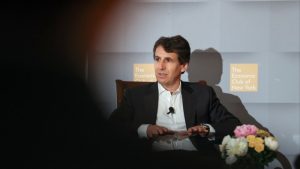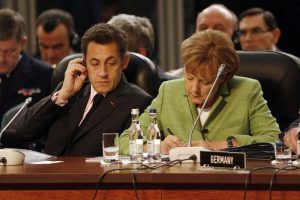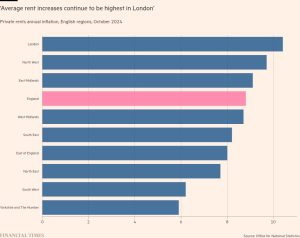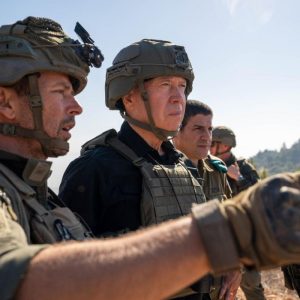Where should we place our faith?
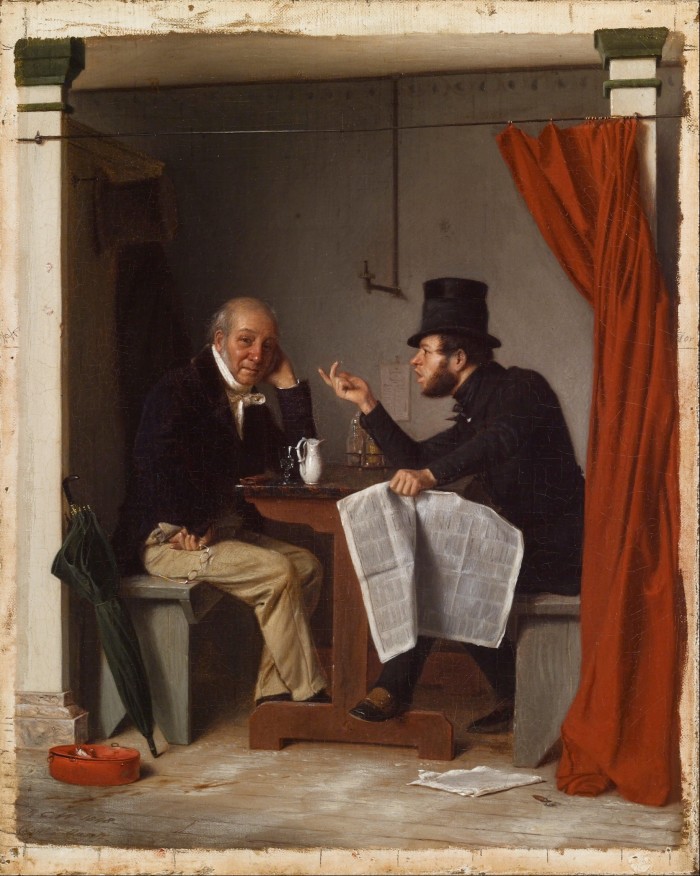
Over the past few days I’ve had conversations with friends and colleagues living in four separate countries. One thing that comes with having regular contact with people in different parts of the world is that I always get some sense of their sociopolitical perspective on what is happening where they are, wherever I happen to be. And despite all the expected variation from one country to the next, what seems clear is that people everywhere are harbouring feelings of uncertainty and concern about our collective future.
I’ve found myself thinking about where it is many of us look to place our faith. Not necessarily the idea of faith in a traditional religious sense, though it may be that, but in the broader sense of where or in what or whom we put our belief and confidence for experiencing the life for which we hope, peaceful and free.
“Politics in an Oyster House”, a painting from 1848 by the American artist Richard Caton Woodville, is held at the Walters Art Museum in Baltimore. Two elegantly dressed men from different generations sit across from one another at a wooden table in a booth of a restaurant. A red curtain that could offer privacy is pulled back, so we are privy to their interaction.
The younger man on the right of the canvas with his top hat still on looks intently at the older man, while holding an open newspaper in one hand and gesturing passionately with the other. It seems that he is sharing his opinions about the contents of the newspaper, and we can assume it is political in nature.

The older man, even though he is being directly addressed by his companion, has turned to face the viewer. His left hand rests against the side of his head as though cupping his ear closed, his right hand holds his glasses and rests on his thigh, and he has a look of slight amusement on his face as he glances at us. I love the way the body language of both men offers insight into their different attitudes, and also gives us viewers more to think about.
From their posture and facial expressions, my own interpretation of the painting is that the young man feels passionately about the politics of his day, perhaps because he expects the elected leadership to act more in the best interests of people and society. So, frustrations arise when the faith he has placed in this leadership fails him. The older gentleman looks as though life has already shown him what happens when you put too much of your faith in politics, and he is mildly entertained by the young man’s naïveté.
It’s an interesting scene to me because it makes me wonder about which side of the booth to sit on. One can understand the need to have faith in good leadership to make the best decision for society, but as we also know, politics rarely serves the best interest of everyone, even in democracies. There will always be people on the margins who do not get the same opportunities or freedoms, and who they are is largely determined by who makes up the majority and whose voices are most powerful in leadership.
World history gives evidence to this again and again. The passion of the man on the right could be admirable or it could be potentially dangerous, depending on how his faith in politics plays out, and whose interests are deemed more valuable than others. I wonder too, if the older man’s gaze might also be one of questioning how much he too should perhaps still have faith in political leadership. And if he chooses not to, where then does he turn for support, and where do we?
In the 1514 work “The Money Lender and His Wife” by the Flemish painter Quentin Matsys, we see a couple sitting side by side attending to their respective duties. There is a lot of detail in this painting. The shelves in the background are lined with books, an empty vase, a snuffed-out candle, a piece of fruit and other items. In the foreground, the money changer sits at a table of treasures. We cannot see his eyes because he is gazing down intently at the gold coins he is weighing.
He holds the scales carefully between his slim fingers with a delicacy one might reserve for a thing of great value. Even his body leans in towards the money. His wife, beside him, holds a prayer book, but instead of reading it her attention is diverted by her husband’s activity. The couple’s rapt interest in material wealth seems to have an almost spiritual intensity.
This painting was made at a time of religious conflict and growing division in Europe. The Protestant Reformation began just three years later in 1517, with Martin Luther’s 95 Theses. It was an era when people were beginning to openly question what they believed and to reconsider their faith. We are living in very different times today, although organised religions or spiritual paths of any kind will always have tenets and practices to inspire and those of which to be wary.
But I was taken by this work because, regardless of people’s religious or spiritual beliefs, many of us still anchor our hope for the future by placing faith presently in our financial, or at least material, accumulations. We live in societies that teach us that the more we own, the safer we will be, to the extent that fear of not having enough, which also equates to feeling not in control of our own lives, can lead us to favour decisions and political policies that promise to secure our own wellbeing at a cost to others.
It’s fascinating because the nature of faith is to actively place trust in a thing, system or person without certainty, and yet many of us seem to believe that only things that are predictably and reliably in our favour are worthy of our confidence or trust.
I don’t think we consciously sit around and decide to place our faith in money and resources but I do think we naturally feel more confident about our lives if we can control them. The only problem is that this sense of control is mostly an illusion.
Much of what happens in life happens in spite of our efforts to orchestrate it. Maybe this painting is a work that invites us to think about what we are devoted to, what else competes for that devotion, and where we choose to place our faith.
I love the 2024 painting “Joie de Vivre” by British-Nigerian artist Joy Labinjo. Three children of different ethnicities play together in an open park alongside a young brown-skinned woman. There is an expanse of green grass and there are trees in the background across a quiet lake. In the foreground of the image, the children chase a green and a red ball, as the woman, wearing jeans, a patterned shirt and hijab, laughingly tries to intervene.
I picked this painting to symbolise an example of where we might put our faith because I think it represents so many things to which people aspire.

We often say that children are the future, so obviously it matters how we take care of our children on both a daily basis and through policies and practices on a larger scale. This painting of happy children from different backgrounds may seem simplistic, even romantic, but it reminds me that if we are concerned about our futures, we should be concerned about the present conditions of children across the world, not least those suffering as a result of poverty or conflict.
It seems it would be in all of our best interests to put our faith not just in children but in the diversity of young people who represent the next generation. And just as when putting our faith in politics or money we do that by our actions, to put our faith in children and young people we would all be required to also do something active and intentional, whether that is considering ways to create safer spaces for children in domestic, communal and educational environments or voting for policies that support the welfare of children.
I suspect there are countless big and small opportunities within our individual communities in which we could figure out a way to act towards the greater wellbeing of children. But I almost want to challenge us to also think of those children who may not be right under our noses.
Where in the world right now do we know of where there are children experiencing such difficulties but that we would rather not confront the reality of? What would it mean to put faith in them? I’m just thinking aloud with you.
In a way it takes us back to the idea of spiritual faith requiring works but in this case it is works that are for the benefit of others and not just ourselves. The future of peace and security naturally requires us to look beyond our own self-interest and to remember that difference in perspective or ideology ultimately shouldn’t keep us from the care needed to ensure futures for everyone.
What would it look like to practise such a faith in each of our lives and communities today?
Email Enuma at [email protected]
Find out about our latest stories first — follow FT Weekend on Instagram and X, and subscribe to our podcast Life & Art wherever you listen
#place #faith
